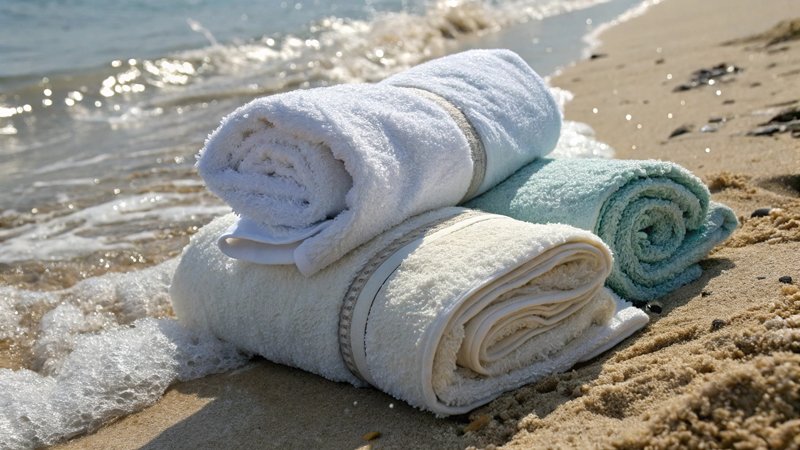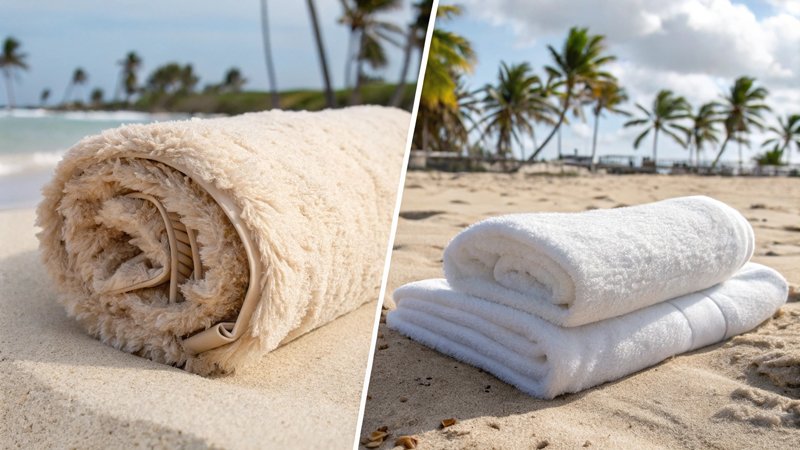Perfect. Based on your structure, here’s the full draft article in your requested format and tone:

I’ve spent over a decade in the beach towel business, and if there’s one debate that always comes up, it’s this: tech fabrics vs. traditional cotton. Let’s finally settle it.
Quick-drying tech fabrics are engineered to wick moisture away from the skin and dry rapidly, while traditional materials like cotton absorb and hold onto water. Choosing the right one can impact everything—from drying time and feel, to weight, longevity, and branding possibilities. Here's a breakdown to help you make the smartest pick for your brand.
I’ve tested, touched, and manufactured both. Here’s what I’ve learned.
What Are Quick-Drying Tech Fabrics?
These are synthetic or blended materials designed for performance—think microfiber, polyester blends, or recycled poly fabrics.
Quick-drying fabrics work by using tightly woven fibers that repel water instead of soaking it up. They’re lightweight, breathable, and dry up to 3x faster than cotton. Ideal for humid environments and active lifestyles.

How Do Quick-Dry Fabrics Work?
Quick-dry materials are hydrophobic—they resist water. So instead of absorbing moisture, they push it to the surface where it can evaporate quickly. That means less sogginess, less weight, and more comfort after every swim.
They also:
- Dry faster (often in under an hour)
- Are thinner and pack smaller
- Don’t smell musty like damp cotton
- Work great for printing bold designs with sharp detail
And here’s the bonus: many quick-dry fabrics today are made from recycled materials, so they’re eco-conscious too.
Traditional Materials (Like Cotton): Pros and Cons
Ah, cotton—the classic beach towel material. Soft, familiar, and absorbent.

Cotton towels feel luxurious and have that plush “hotel towel” vibe. They’re great at soaking up water, but not so great at letting it go. Once wet, they stay wet. And heavy.
When Does Cotton Shine?
If your brand is going for softness, traditional charm, and a premium feel, cotton still holds strong. It’s easy to source, customizable, and often cheaper in lower grades. But be careful: cheap cotton gets stiff, frays fast, and can lose shape after a few washes.
Here’s a quick breakdown:
| Feature | Cotton Towels | Quick-Dry Fabrics |
|---|---|---|
| Absorbency | High | Moderate |
| Drying Time | Slow | Fast |
| Weight | Heavy when wet | Lightweight |
| Odor Retention | High | Low |
| Design Options | Decent | Excellent |
| Eco Options | Organic available | Recycled fabrics common |
5 Key Comparisons: Quick-Dry vs. Traditional Materials
Let’s go side-by-side.
1. Weight: Quick-dry towels are feather-light, even when wet. Cotton gets bulky and heavy.
2. Drying Speed: Tech fabrics win hands-down. Cotton can take hours to fully dry.
3. Space & Packability: Quick-dry towels fold into compact rolls. Cotton? Not so much.
4. Durability: Quick-dry holds up better after repeated washes and sun exposure.
5. Feel: Cotton feels softer initially, but high-quality microfiber has closed the gap.
So if performance matters more than nostalgia, quick-dry wins in most categories.
Industry Insight: Why Quick-Dry Fabrics Are Taking Over
I’ve worked with brands across 20+ countries, and here’s what I’m seeing:
Quick-dry is the future. Customers want lighter, faster-drying, more practical towels that don’t feel soggy after one use.

Retailers love how compact they are to ship and stock. E-commerce sellers love the visual appeal—they look sharp and bold in product photos. And travelers? They want towels that fit in backpacks and dry between swims.
But there’s a secret weapon: branding. Sublimation prints on tech fabrics pop like a summer sunset. Designs are sharper, more vibrant, and more durable. You simply can’t get that level of detail on regular cotton.
Common Misconceptions & How to Choose Wisely
Let’s clear up some confusion:

- “Cotton is always better.” Not true. It’s only better if softness is your only priority.
- “Quick-dry feels like plastic.” Not anymore. High-end microfiber feels smooth, almost velvety.
- “Tech towels don’t absorb well.” They do—they just don’t stay wet.
My advice? Sample both. Touch them. Try them wet. Think about your brand’s values. Want soft and cozy? Go for ring-spun cotton. Want performance, speed, and bold designs? Tech fabrics win.
Conclusion: Which Material Is Right for You?
Choose based on your customer’s lifestyle. Cotton charms. Quick-dry performs. There’s no one-size-fits-all—just the one that fits your brand.
Expert Insight (From 15 Years in the Industry):
I used to think cotton was the gold standard—until I spent a rainy day at a beach photoshoot, lugging around soggy towels that took hours to dry. That moment flipped the switch for me. Now, almost every new brand I help launch starts with quick-dry materials. The tech, the print quality, the user experience—it’s just a better fit for how people live today.
Let me know if you'd like a version with your branding callouts or tailored for a specific type of reader (e.g., e-commerce owners vs. boutique brands)!






